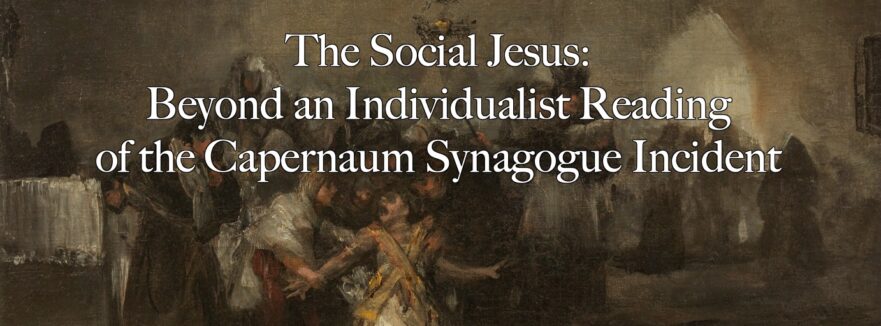How to cite this article: Joshua N. Tilton, “The Social Jesus: Beyond an Individualist Reading of the Capernaum Synagogue Incident,” Jerusalem Perspective (2023) [https://www.jerusalemperspective.com/27611/].
| Rather listen instead? |
| JP members can click the link below for an audio version of this essay.[*]
Paid Content
Premium Members and Friends of JP must be signed in to view this content. If you are not a Premium Member or Friend, please consider registering. Prices start at $5/month if paid annually, with other options for monthly and quarterly and more: Sign Up For Premium  |
Readers of the New Testament Gospels who have inherited the modern individualist mindset often miss important social dynamics at play in the stories about Jesus. When Jesus healed the sick, proclaimed forgiveness to sinners, and expelled demons, he did so within a social context and not merely on an individual, one-on-one basis. Jesus’ message and his miracles had an effect on the entire community, not just on the individuals immediately involved. Removing our individualist blinders can help us more fully appreciate what is going on in the Gospel accounts and can help us understand why the drama unfolds the way it does. Reading the Gospels from a social perspective can also make sense of unusual or disturbing details that are typically ignored or overlooked because they do not fit into an individualist frame of reference.
To demonstrate the usefulness of a social approach to the Gospel narratives we will take a fresh look at the Capernaum Synagogue incident found in Mark 1:21-28 and Luke 4:31-37. Since the differences between these parallel accounts will not be of much importance for the purposes of our investigation, we will primarily follow Luke’s version, which, in our view, has certain features that are more authentic than the version found in Mark.
Premium Members and Friends of JP must be signed in to view this content.
If you are not a Premium Member or Friend, please consider registering. Prices start at $5/month if paid annually, with other options for monthly and quarterly and more: Sign Up For Premium
Conclusion
It is the social, rather than the individualist, reading of the Capernaum Synagogue incident that makes the best sense of its details and taps its full potential. In place of the anemic conception of Jesus relating only to individuals, we have begun to appreciate an understanding of the social Jesus who creates and sustains community.
For more on the Capernaum Synagogue incident, check out these JP articles:
David Flusser, “Teaching with Authority: The Development of Jesus’ Portrayal as a Teacher within the Synoptic Tradition”
Joshua N. Tilton and David N. Bivin, “Teaching in Kefar Nahum” (a segment of the LOY Commentary)

- [1] In Mark’s version of the story the reason given for the people’s amazement is that “he was teaching them as one having authority and not as the scribes.” Thus, whereas Luke’s version centers the authority in Jesus’ teaching, Mark’s version centers the authority in Jesus’ person. Luke’s emphasis on the authority of Jesus’ message strikes us as more authentic than Mark’s emphasis on the authority of Jesus’ person. Mark’s polemical remark at the expense of the scribes also seems colored by tensions between the early believers and the mainstream Jewish community, and therefore less authentic than Luke’s more neutral account. ↩
- [2] In Mark’s version of the story the people ask, “What is this? A new teaching with authority? He even commands the impure spirits and they listen to him!” Mark’s reference to a “new teaching,” which is therefore better than the teachings of the scribes, appears apologetic, whereas the people’s more logical question in Luke seems more authentic. ↩
- [3] See Alfred Plummer, A Critical and Exegetical Commentary on the Gospel According to St. Luke (International Critical Commentary; 5th ed.; Edinburgh: T&T Clark, 1922 [orig. pub. 1896]), 133. ↩
- [4] See Alexander Balmain Bruce, The Synoptic Gospels (6th ed.; Expositors Greek Testament; London: Hodder and Stoughton, 1910 [orig. pub. 1897]), 345. ↩
- [5] Cf. Joseph A. Fitzmyer, The Gospel According to Luke (2 vols.; Anchor Bible; Garden City, N.Y.: Doubleday, 1981, 1985), 1:545; John Nolland, Luke (3 vols.; Word Biblical Commentary; Dallas: Word Books, 1989, 1993, 1993), 1:204. ↩
- [6] See William Manson, The Gospel of Luke (MNTC; London: Hodder and Stoughton, 1930), 45; Francis Wright Beare, The Earliest Records of Jesus (Oxford: Basil Blackwell, 1962), 48 §12; Robert H. Gundry, Mark: A Commentary on His Apology for the Cross (2 vols.; Grand Rapids: Eerdmans, 1993), 1:75. ↩
- [7] See Beare, Earliest Records of Jesus, 48 §12. ↩
- [8] See Ezra P. Gould, A Critical and Exegetical Commentary on the Gospel According to St. Mark (ICC; Edinburgh: T&T Clark, 1896), 23; Plummer, Luke, 1:35; Bruce, Synoptic Gospels, 345; Henry Barclay Swete, The Gospel According to St. Mark (3d rev. ed.; London: Macmillan, 1913 [orig. pub. 1898]), 19; Benjamin Wisner Bacon, The Beginnings of Gospel Story (New Haven, Conn.: Yale University Press, 1909), 17-18; Fitzmyer, Luke, 1:545; Nolland, Luke, 1:207; François Bovon, Luke: Hermeneia—A Critical and Historical Commentary on the Bible (3 vols.; trans. Donald S. Deer [Evangelium nach Lukas, 1989-2009]; Minneapolis: Fortress, 2002, 2013, 2012), 1:162 n. 27; Joel B. Green, The Gospel of Luke (Grand Rapids: Eerdmans, 1997), 223. ↩
- [9] Graham H. Twelftree (Jesus the Exorcist: A Contribution to the Study of the Historical Jesus [Peabody, Mass.: Hendrickson, 1993], 61 n. 25) considered the possibility that “the plural used by the demon refers to those around Jesus at the time,” but concluded that there is nothing “to support his notion.” Cf. Gundry, Mark, 1:75. ↩
- [10] See Twelftree, Jesus the Exorcist, 67; Joel Marcus, Mark (2 vols.; Anchor Bible; Garden City, N.Y.: Doubleday, 2000; New Haven and London: Yale University Press, 2009), 1:187-188; R. T. France, The Gospel of Mark: A Commentary on the Greek Text (Grand Rapids: Eerdmans, 2002), 104; Amanda Witmer, Jesus, the Galilean Exorcist: His Exorcisms in Social and Political Context (London: T&T Clark, 2012), 160-161. ↩
- [11] See Guelich, 57; Nolland, Luke, 1:207. ↩
- [12] Cf. Matt. 12:43; Luke 11:24. ↩
- [13] Cf. Matt. 8:28; Mark 5:3, 5; Luke 8:27; Midrash Tannaim 18:11 (ed. Hoffmann, 110) (cf. b. Sanh. 65b); y. Ter. 1:1 [2a] (cf. y. Git. 7:1 [38b]); Avot de-Rabbi Natan, Version A §3 (ed. Schechter, 16-17). ↩
- [14] Cf. Luke 8:29; b. Ber. 3b. ↩
- [15] Cf. b. Shab. 65b; b. Git. 70a. ↩
- [16] Cf. b. Pes. 112b. ↩
- [17] In 1 Kgs. 22:22-23 ∥ 2 Chr. 18:21-22 a lying spirit (רוּחַ שֶׁקֶר [rūaḥ sheqer]) misleads the king of Israel by spreading misinformation by means of false prophets. ↩
- [18] The Qumran covenanters linked jealousy ברוח רשעה (berūaḥ reshā‘āh, “in a wicked spirit”) with greed (1QS X, 18-19), while according to b. Sot. 3a some ancient Jewish sages believed that the spirit of jealousy (רוּחַ קִנְאָה [rūaḥ qin’āh; Num. 5:14, 30]) that aroused a man to suspect his wife of adultery was an impure spirit. ↩
- [19] The members of the Qumran sect were required to hate outsiders ברוח הסתר (berūaḥ haseter, “in the clandestine spirit”; 1QS IX, 21-22). ↩
- [20] The prophet Hosea warned of a spirit of prostitution (רוּחַ זְנוּנִים [rūaḥ zenūnim]; Hos. 4:12; 5:4) that enticed Israel from faithfulness to the LORD and prevented repentance. ↩



